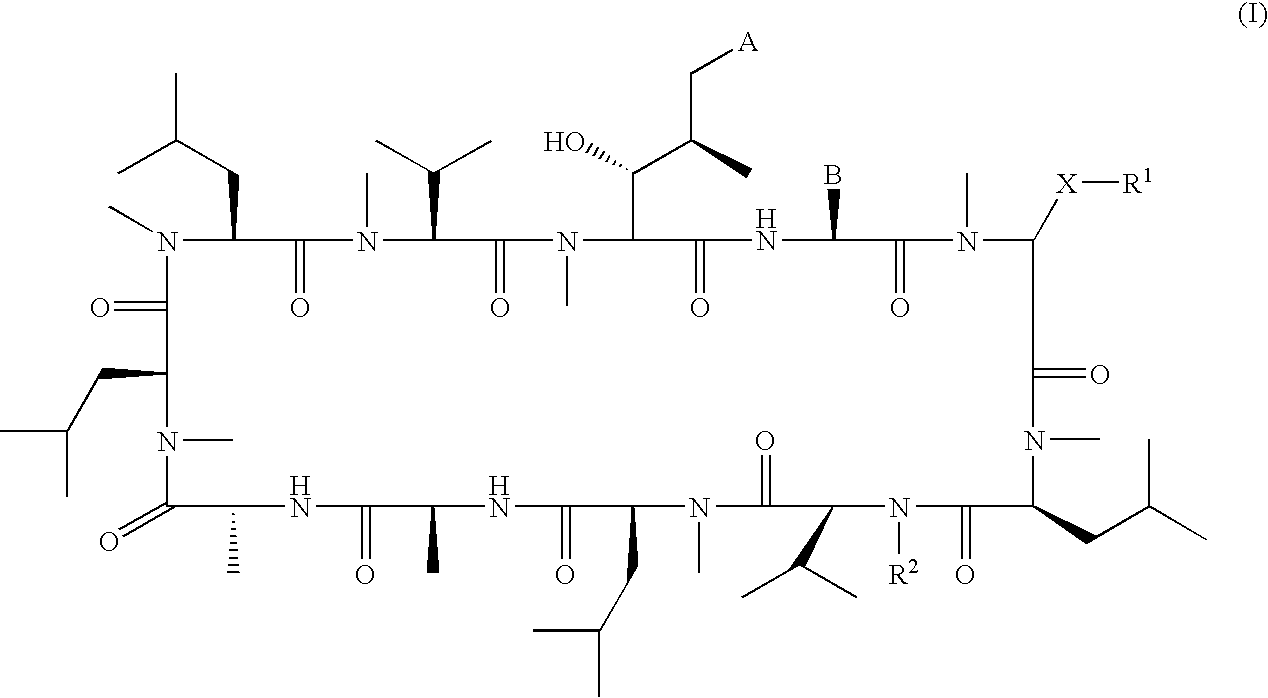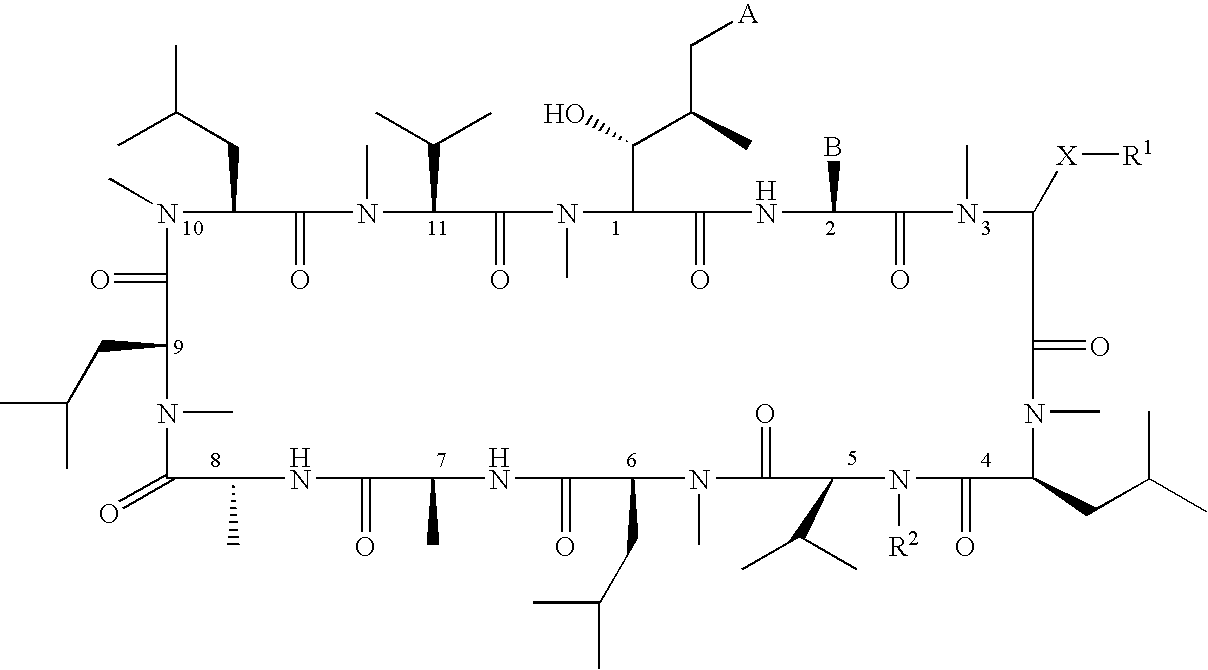Novel macrocyclic peptides
a macrocyclic peptide and peptide technology, applied in the field of new cyclosporine derivatives, can solve the problem that the enucleation of tumors by operation does not help appreciably
- Summary
- Abstract
- Description
- Claims
- Application Information
AI Technical Summary
Problems solved by technology
Method used
Image
Examples
example 1
[0333]Diisopropylamine (300 mg) was dissolved in anhydrous tetrahydrofuran. This solution was cooled to −25° C. under nitrogen. n-Butyl lithium (2.5M / hexanes, 1.2 mL) was added and then the mixture was stirred for 30 minutes at −25° C. N-Benzyl-Val5-cyclosporine A (320 mg) made, for example, according to Reference Example 1, was dissolved in anhydrous tetrahydrofuran, and was added to the solution. The mixture was kept at this temperature for 90 minutes and then toluene-4-thiosulfonic acid S-(2-dimethylaminoethyl)ester (390 mg) in anhydrous tetrahydrofuran was added to the solution. The solution was stirred at −25° C. for 2 hours and then left to warm to room temperature overnight. The reaction was quenched by adding a saturated solution of ammonium chloride and then extracted twice with ethyl acetate. The combined organic layers were dried over sodium sulfate and concentrated. Some of the crude material was purified using HPLC to give [(R)-2-(N,N-dimethylamino)ethylthio-Sar]3-(N-Be...
example 2
[0337][(R)-Methylthio-Sar]3-cyclosporine A (150 mg) made, for example, according to Reference Example 2, and benzyl bromide (85.5 mg) were charged in an oven dried flask. Anhydrous tetrahydrofuran was added to the reaction vessel. This solution was cooled to −78° C. under a stream of nitrogen. Phosphazene base P4-tBu (CAS: [111324-04-0], 1M / hexanes, 0.5 mL) was slowly added. The reaction mixture was left to warm to −30° C. and then quenched with citric acid (1N). The reaction was further diluted with ethyl acetate and then extracted twice with ethyl acetate. The combined organic layers were washed with saturated solutions of sodium bicarbonate and then brine. After drying over sodium sulfate, it was concentrated and purified by flash chromatography (40 g ISCO silica cartridge, gradient ethyl acetate / heptanes) to afford [methylthio-Sar]3-(N-benzyl)-Val5-cyclosporine A (Compound 4) as a white solid, 1H NMR (400 MHz, DMSO-d6) δ ppm 1.66 (s, 3H) 2.45 (s, 3H) 2.47 (s, 3H) 2.48 (s, 3H) 2....
example 3
[0350]To a solution of [methylthio-Sar]3-N-[trans-4-(3′,4′-dimethoxy)benzyloxy-but-2-enyl]-Val5-cyclosporine A (Compound 12) (0.25 g) in a solvent mixture of dichloromethane and water was added 2,3-dichloro-5,6-dicyano-p-benzoquinone (DDQ) (40 mg) and the resulting mixture was stirred at room temperature for 2 hours. It was diluted with dichloromethane, washed with saturated sodium bicarbonate solution, saturated sodium chloride solution, and then concentrated under reduced pressure. The crude product was purified using flash silica gel column chromatography, eluting with a gradient of 0 to 100% ethyl acetate in heptane to yield [methylthio-Sar]3-N-[trans-4-hydroxy-but-2-enyl]-Val5-cyclosporine A (Compound 14) as a white solid; 1H NMR (400 MHz, DMSO-d6) δ ppm 2.04 (s, 3H) 2.79 (s, 3H) 2.80 (s, 3H) 2.83 (s, 3H) 2.84 (s, 3H) 2.93 (s, 3H) 2.96 (s, 3H) 3.21 (s, 3H) 5.78-5.82 (m, 1H), 6.25 (s, 1H) 6.61 (d, 1H) 8.14 (d, 1H) 8.51 (d, 1H); mass spectra: 1318.9, (M+H).
[0351]By proceeding in ...
PUM
| Property | Measurement | Unit |
|---|---|---|
| temperature | aaaaa | aaaaa |
| temperature | aaaaa | aaaaa |
| weight percent | aaaaa | aaaaa |
Abstract
Description
Claims
Application Information
 Login to View More
Login to View More - R&D
- Intellectual Property
- Life Sciences
- Materials
- Tech Scout
- Unparalleled Data Quality
- Higher Quality Content
- 60% Fewer Hallucinations
Browse by: Latest US Patents, China's latest patents, Technical Efficacy Thesaurus, Application Domain, Technology Topic, Popular Technical Reports.
© 2025 PatSnap. All rights reserved.Legal|Privacy policy|Modern Slavery Act Transparency Statement|Sitemap|About US| Contact US: help@patsnap.com



